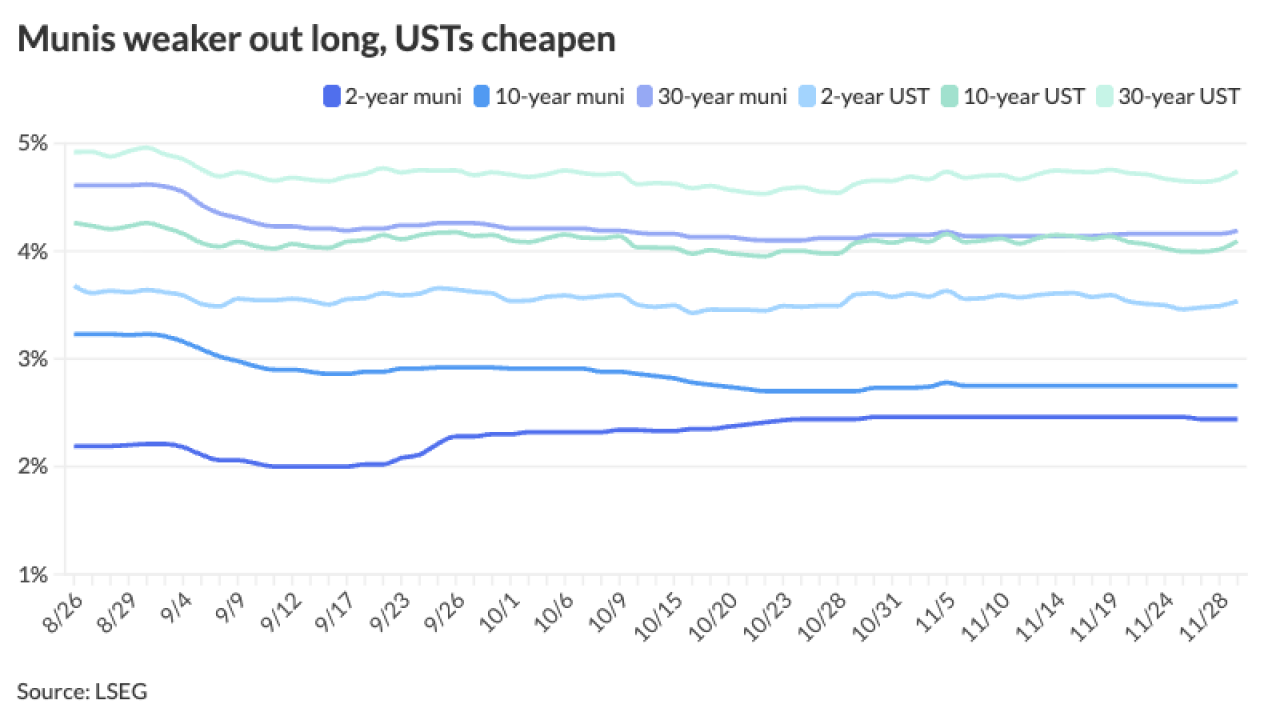
The Dormitory Authority of the State of New York plans to price $1 billion of school district revenue bonds on Tuesday.
The billion-dollar deal will reimburse 74 New York school districts for their capital projects with bonds backed by state revenue.
"Our DASNY School District revenue bond financing program is one that we're extraordinarily proud of," DASNY CEO Robert J. Rodriguez said. "It gives us an opportunity to provide public school districts across New York state with an efficient, long term financing option that helps them fund their capital projects."
The negotiated deal consists of three tranches.
Series 2025A will consist of $988 million, with maturities from 2026 to 2052, and 69 participating school districts.
Series 2025B's $28 million of bonds will support two districts: the Byron-Bergen Central School District and the City School District of the City of Elmira. The bonds have maturity dates from 2026 to 2040.
The third tranche, $21 million of series 2025C, has maturity dates from 2026 to 2044. It will support three districts: the Ravena-Coeymans-Selkirk Central School District, the City School District of the City of Utica and the Weedsport Central School District.
The deal is rated Aa3 by Moody's Ratings and AA-minus by Fitch Ratings.
The bond rating isn't based on the school districts' finances, Fitch analyst Tammy Gamerman said. Instead, it's based on the state's credit quality.
Through New York's intercept program, if one of the districts in the deal is delinquent on its payments, the state comptroller will intercept the school's building aid to pay the debt service.
DASNY issues its school district revenue bonds once a year through its intercept program, which Rodriguez said has existed since 2002. The program allows the schools to "align their borrowing costs with the aid that they receive from the state," he said.
School district bonds in New York are typically backed by building aid reimbursement from the state, Rodriguez explained.
"They do that either through a statewide average interest rate that's dispersed at the time that the project receives approval from the state," Rodriguez said, "Or they can go through us, and building aid, in that case, is reimbursed at the actual rate that they receive for their bond series."
DASNY typically sees more demand from school districts in higher interest rate environments, Rodriguez said.
"Because the actual cost on the reimbursement rate that they'll receive is higher than in a lower interest rate environment," Rodriguez said, "they might have the statewide average be lower than the actual cost."
Between 2012 and 2022, DASNY's school district deals were around $350 million on average. Since then, the deals have been more than $700 million every year.
In order to participate in a DASNY deal, a school district's capital projects must be approved by the state Department of Education and its bond resolution must have local approval, Rodriguez said.
Sometimes DASNY's school district deals have separate series based on school districts' credit ratings if there's a big enough distinction between schools, Rodriguez said.
But for this deal, the series were separated based on the date the districts need to access the funds. The two smaller series have later closing dates.
All of the schools participating in the deal have entered into a financing agreement with DASNY. The online investor presentation described the components of the agreement:
"Each school district has assigned and pledged to DASNY a sufficient portion of any and all pledged revenues — the primary component of pledged revenues is state aid payable to the school district," the investor presentation said. Each district "will deliver its general obligation bonds to DASNY evidencing its obligation to make required payments under the financing agreement."
The program's credit rating, Gamerman said, is a notch lower than comparable state programs because of a structural quirk.
"In this program, historically, there hasn't always been sufficient coverage in what we call the intercept period — the time between when debt service is due and when state aid appropriation happens," Gamerman said. "There's no mechanism to accelerate the state aid appropriation here."
As for the state aid, legislature New York Gov. Kathy Hochul signed the state budget Friday. The budget includes
New York's school aid has increased at an average of 5.8% each fiscal year since 2023, the investor presentation said.
In last year's budget, Hochul proposed changes to the school funding formula that would have decreased the aid sent to some schools. Hochul suggested eliminating the state's "hold harmless" provision, which prevents a school's aid from decreasing if its enrollment declines.
That proposal didn't make it into the final budget and was absent from Hochul's executive budget this year. The only major change proposed to the school aid formula was updating outdated poverty calculations.
The status of New York's federal school funding is much less clear. The Trump administration is seeking to
The state's building aid is completely separate from the federal budget, so the threat of federal cuts won't impact the credit or debt service on these bonds, Rodriguez said.
"Certainly there's a lot of uncertainty for school districts. Same goes for all local governments, state governments as well," Gamerman said. "Congress is just starting to go through the budget reconciliation process. There's a lot of proposals out there at this point. We don't know where there may be cuts, but there's certainly heightened uncertainty."
Federal uncertainty has fueled volume in the higher education sector, but Rodriguez said New York's school districts have not seen a notable increase in borrowing.
Still, Rodriguez said, school districts "are listening to and understand trends that are happening in the marketplace. They're certainly considering the potential increase in costs to their capital programs that could come from a variety of different sources."
RBC Capital Markets is the senior underwriter on the deal, with Raymond James and Roosevelt and Cross as co-senior underwriters. The deal has 14 other underwriters. Barclay Damon and BurgherGray are co-counsels.





